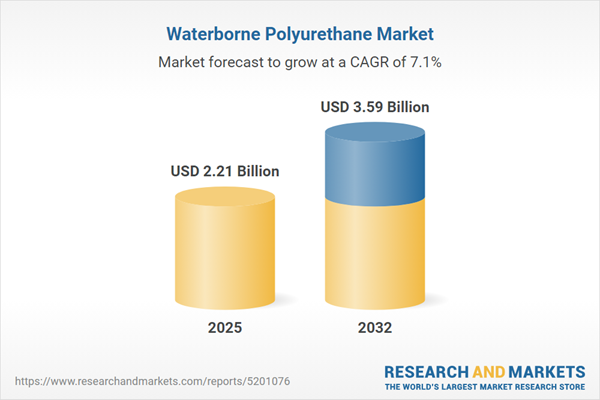Speak directly to the analyst to clarify any post sales queries you may have.
Senior decision-makers are leveraging waterborne polyurethane to achieve essential objectives in sustainability, compliance, and value chain efficiency. As organizations seek to future-proof operations and reinforce supplier partnerships, advanced polyurethane solutions enable responsible growth and competitive positioning across key industrial sectors.
Market Snapshot: Waterborne Polyurethane Market Trends
The global waterborne polyurethane market is expanding due to the sector's drive for eco-friendly materials and widespread adoption of low-emission technologies. Industries such as automotive, construction, packaging, furniture, and textiles are integrating waterborne polyurethane into applications that must meet updated environmental compliance and shifting stakeholder priorities. As organizations respond to regulatory mandates and expectations for transparent, durable solutions, there is a parallel need for agile supply chains. Regional supply practices adapt to local efficiency and policy requirements, further supporting market development and encouraging alignment between suppliers and end users seeking sustainable business models.
Scope & Segmentation of the Waterborne Polyurethane Market
- Automotive Manufacturers: Employ waterborne polyurethane for both manufacturing and refinishing to achieve durable finishes while meeting environmental standards across evolving product lines.
- Construction Firms: Use polyurethane in flooring, insulation, and wall systems, contributing to green building goals and enhanced resource management in commercial and residential settings.
- Furniture Producers: Opt for low-emission polyurethane coatings to improve operational efficiency and satisfy institutional customers' advanced sustainability requirements.
- Packaging Providers: Select waterborne polyurethane to maintain product integrity throughout intricate distribution networks, aligning material selection with logistics needs.
- Textile and Footwear Manufacturers: Integrate customized polyurethane coatings that provide abrasion resistance and extend product life, strengthening B2B partnerships and market standing.
- Technology Types: Acrylic, aliphatic, and aromatic chemistries each offer particular benefits such as UV resistance, superior clarity, or high mechanical strength across multiple industry uses.
- Component Systems: One-component and two-component solutions match a range of production requirements, from simple mass applications to complex formulations demanding precise crosslinking and enhanced performance.
- Regions Covered: Analysis includes the Americas, Europe, Middle East and Africa, and Asia-Pacific, highlighting region-specific sourcing, regulatory, and operational dynamics impacting adoption.
- Major Companies Profiled: Covestro AG, BASF SE, Dow Inc., Wanhua Chemical Group Co., Ltd., Huntsman International LLC, The Lubrizol Corporation, Evonik Industries AG, Allnex Belgium SA/NV, Mitsui Chemicals, Inc., and Wacker Chemie AG, all recognized for industry innovation and adaptability.
Key Takeaways for Senior Decision-Makers
- Sourcing waterborne polyurethane sustainably is now a standard in supplier evaluation, improving continuity and aligning with ESG priorities as scrutiny around supply chains grows.
- Recent advancements in polyurethane formulations offer organizations new pathways to adapt technical capabilities and ensure compliance amid evolving sector requirements.
- Robust collaboration throughout the supply chain fosters compliance achievements and spurs ongoing improvements in processes related to sourcing and delivery.
- Regional differentiation is shaping market direction: Asia-Pacific maintains a focus on output expansion, while North America and Europe prioritize efficiency and swift responses to new regulatory guidelines.
- Market leaders are shifting toward bio-based polyurethane options and evolving operational structures to maintain competitiveness as environmental and regulatory environments change.
Tariff Impact: Adapting Sourcing and Supply Chain Models
US tariff amendments on critical raw materials are causing waterborne polyurethane producers to rethink their sourcing and logistics approaches. Companies are building resilience through global supplier partnerships and nearshoring initiatives to achieve predictable costs and uninterrupted supply. Investments aimed at lowering emissions play a key role in supplier assessments and risk management, emphasizing the need for adaptable supply chains within a complex and fluctuating regulatory environment.
Methodology & Data Sources
This report draws on in-depth secondary research and direct interviews with technical and procurement specialists. The methodology includes structured bottom-up research and scenario-based modeling for actionable insights tailored to senior leadership priorities.
Why This Report Matters
- Clarifies how regulatory, sustainability, and operational factors interact, supporting the accelerated implementation of waterborne polyurethane across industries.
- Equips executive teams to anticipate disruptions and proactively position for new market opportunities in supply chain strategy.
- Details critical innovation pathways supporting effective policy management and sustained sector growth.
Conclusion
Adopting waterborne polyurethane strengthens organizational sustainability strategies and supply stability, enabling companies to proactively address regulatory shifts. Focused partnerships and targeted technology upgrades promote readiness for dynamic market demands.
Additional Product Information:
- Purchase of this report includes 1 year online access with quarterly updates.
- This report can be updated on request. Please contact our Customer Experience team using the Ask a Question widget on our website.
Table of Contents
3. Executive Summary
4. Market Overview
7. Cumulative Impact of Artificial Intelligence 2025
Companies Mentioned
The companies profiled in this Waterborne Polyurethane market report include:- Covestro AG
- BASF SE
- Dow Inc.
- Wanhua Chemical Group Co., Ltd.
- Huntsman International LLC
- The Lubrizol Corporation
- Evonik Industries AG
- Allnex Belgium SA/NV
- Mitsui Chemicals, Inc.
- Wacker Chemie AG
Table Information
| Report Attribute | Details |
|---|---|
| No. of Pages | 186 |
| Published | November 2025 |
| Forecast Period | 2025 - 2032 |
| Estimated Market Value ( USD | $ 2.21 Billion |
| Forecasted Market Value ( USD | $ 3.59 Billion |
| Compound Annual Growth Rate | 7.1% |
| Regions Covered | Global |
| No. of Companies Mentioned | 11 |









